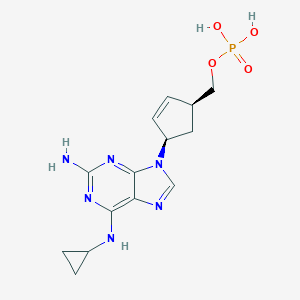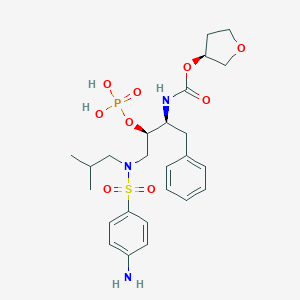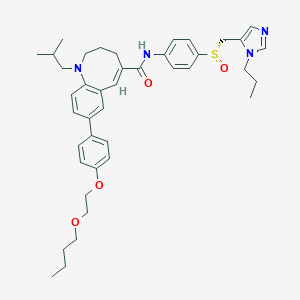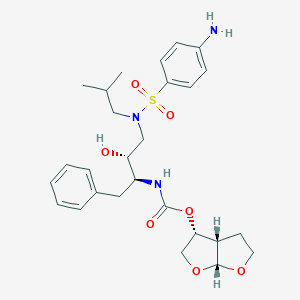
达鲁那韦
描述
Darunavir is a nonpeptidic inhibitor of protease used primarily in the treatment and prevention of human immunodeficiency virus (HIV) infection. It is often administered in combination with other antiretroviral agents to enhance its efficacy. Darunavir was approved by the United States Food and Drug Administration in 2006 and is included in the World Health Organization’s List of Essential Medicines .
作用机制
达鲁那韦通过抑制 HIV-1 蛋白酶发挥作用,该酶对于病毒前体蛋白加工和病毒成熟至关重要。 达鲁那韦通过与酶的活性位点结合,阻止 HIV Gag-Pol 多蛋白的切割,从而阻断感染性病毒颗粒的形成 . 该机制对于其抗逆转录病毒活性至关重要。
类似化合物:
- 安普那韦
- 茚地那韦
- 沙奎那韦
- 奈非那韦
- 利托那韦
比较: 达鲁那韦在蛋白酶抑制剂中独一无二,因为它具有很高的抗药性遗传屏障,并且能够抑制广泛的蛋白酶抑制剂耐药 HIV-1 株 . 与其他一些蛋白酶抑制剂不同,达鲁那韦通常与利托那韦或考比司他联合使用,以增强其药代动力学特性 .
科学研究应用
达鲁那韦在科学研究中有着广泛的应用:
化学: 用作蛋白酶抑制剂研究的模型化合物。
生物学: 研究其与 HIV 蛋白酶和其他生物靶标的相互作用。
生化分析
Biochemical Properties
Darunavir plays a crucial role in biochemical reactions by inhibiting the activity of the HIV-1 protease enzyme. This enzyme is responsible for cleaving the viral polyprotein into functional proteins necessary for viral replication . Darunavir binds to the active site of the HIV-1 protease through multiple hydrogen bonds, thereby preventing the enzyme from processing the viral polyprotein . This inhibition leads to the production of immature, non-infectious viral particles . Darunavir interacts with various biomolecules, including the HIV-1 protease enzyme and other proteins involved in the viral replication process .
Cellular Effects
Darunavir has significant effects on various types of cells and cellular processes. In HIV-infected cells, Darunavir reduces viral load and increases CD4 cell counts, which are crucial for maintaining a healthy immune system . By inhibiting the HIV-1 protease enzyme, Darunavir disrupts the viral replication cycle, leading to a decrease in the production of new viral particles . This inhibition also affects cell signaling pathways, gene expression, and cellular metabolism by preventing the virus from hijacking the host cell’s machinery .
Molecular Mechanism
The molecular mechanism of Darunavir involves its binding to the active site of the HIV-1 protease enzyme. Darunavir forms multiple hydrogen bonds with the enzyme, which stabilizes its binding and prevents the protease from cleaving the viral polyprotein . This inhibition results in the production of immature viral particles that are unable to infect new cells . Additionally, Darunavir’s high affinity for the protease enzyme makes it effective against HIV strains that have developed resistance to other protease inhibitors .
Temporal Effects in Laboratory Settings
In laboratory settings, the effects of Darunavir have been observed to change over time. Darunavir is generally stable and maintains its efficacy over extended periods . Long-term studies have shown that resistance-associated mutations can emerge in patients experiencing virological failure during prolonged use of Darunavir . These mutations can reduce the drug’s effectiveness, necessitating adjustments in treatment regimens .
Dosage Effects in Animal Models
The effects of Darunavir vary with different dosages in animal models. Studies have shown that higher doses of Darunavir result in increased drug concentrations in the brain, liver, and plasma . At high doses, Darunavir can also cause toxic or adverse effects, such as gastrointestinal disturbances and lipid abnormalities . It is essential to determine the optimal dosage to maximize efficacy while minimizing adverse effects .
Metabolic Pathways
Darunavir is primarily metabolized by the cytochrome P450 3A (CYP3A) isoenzymes in the liver . The metabolic pathways involve carbamate hydrolysis, isobutyl aliphatic hydroxylation, and aniline aromatic hydroxylation . Ritonavir, a CYP3A inhibitor, is often co-administered with Darunavir to enhance its bioavailability and prolong its half-life . This combination allows for lower daily doses of Darunavir while maintaining its therapeutic efficacy .
Transport and Distribution
Darunavir is transported and distributed within cells and tissues through various mechanisms. It exhibits sufficient membrane permeability to achieve adequate intestinal absorption . The drug is also subject to active transport processes, such as those mediated by P-glycoprotein (P-gp) or other efflux proteins . These transporters play a role in the drug’s localization and accumulation within different tissues .
Subcellular Localization
The subcellular localization of Darunavir is primarily within the cytoplasm, where it interacts with the HIV-1 protease enzyme . Darunavir’s activity is not significantly affected by targeting signals or post-translational modifications, as its primary function is to inhibit the protease enzyme within the cytoplasmic compartment . This localization ensures that Darunavir effectively disrupts the viral replication process within infected cells .
准备方法
合成路线和反应条件: 达鲁那韦的合成涉及多个步骤,包括关键中间体的形成及其随后的偶联。 一种常见的合成路线包括使用三氟乙酸在二氯甲烷中去除 BOC 基团,然后在三乙胺存在下与碳酸酯反应生成达鲁那韦 .
工业生产方法: 达鲁那韦乙醇盐的工业生产涉及一个稳健的工艺,包括多个分离和干燥步骤。 该工艺确保了高化学产率和纯度,关键工艺杂质控制在所需限度以下 . 此外,还采用热熔挤出和喷雾干燥等方法来提高达鲁那韦的溶解度和生物利用度 .
化学反应分析
反应类型: 达鲁那韦会经历各种化学反应,包括氧化、还原和取代。 它主要由肝脏细胞色素酶,特别是 CYP3A4 氧化和代谢 .
常用试剂和条件:
氧化: 涉及肝脏细胞色素酶。
还原: 达鲁那韦的还原反应很少见。
取代: 涉及与碳酸酯和胺的反应。
主要产物: 这些反应形成的主要产物包括羟基化和葡萄糖醛酸化代谢物 .
相似化合物的比较
- Amprenavir
- Indinavir
- Saquinavir
- Nelfinavir
- Ritonavir
Comparison: Darunavir is unique among protease inhibitors due to its high genetic barrier to resistance and its ability to inhibit a wide range of protease inhibitor-resistant HIV-1 strains . Unlike some other protease inhibitors, darunavir is often used in combination with ritonavir or cobicistat to enhance its pharmacokinetic profile .
属性
IUPAC Name |
[(3aS,4R,6aR)-2,3,3a,4,5,6a-hexahydrofuro[2,3-b]furan-4-yl] N-[(2S,3R)-4-[(4-aminophenyl)sulfonyl-(2-methylpropyl)amino]-3-hydroxy-1-phenylbutan-2-yl]carbamate | |
|---|---|---|
| Source | PubChem | |
| URL | https://pubchem.ncbi.nlm.nih.gov | |
| Description | Data deposited in or computed by PubChem | |
InChI |
InChI=1S/C27H37N3O7S/c1-18(2)15-30(38(33,34)21-10-8-20(28)9-11-21)16-24(31)23(14-19-6-4-3-5-7-19)29-27(32)37-25-17-36-26-22(25)12-13-35-26/h3-11,18,22-26,31H,12-17,28H2,1-2H3,(H,29,32)/t22-,23-,24+,25-,26+/m0/s1 | |
| Source | PubChem | |
| URL | https://pubchem.ncbi.nlm.nih.gov | |
| Description | Data deposited in or computed by PubChem | |
InChI Key |
CJBJHOAVZSMMDJ-HEXNFIEUSA-N | |
| Source | PubChem | |
| URL | https://pubchem.ncbi.nlm.nih.gov | |
| Description | Data deposited in or computed by PubChem | |
Canonical SMILES |
CC(C)CN(CC(C(CC1=CC=CC=C1)NC(=O)OC2COC3C2CCO3)O)S(=O)(=O)C4=CC=C(C=C4)N | |
| Source | PubChem | |
| URL | https://pubchem.ncbi.nlm.nih.gov | |
| Description | Data deposited in or computed by PubChem | |
Isomeric SMILES |
CC(C)CN(C[C@H]([C@H](CC1=CC=CC=C1)NC(=O)O[C@H]2CO[C@@H]3[C@H]2CCO3)O)S(=O)(=O)C4=CC=C(C=C4)N | |
| Source | PubChem | |
| URL | https://pubchem.ncbi.nlm.nih.gov | |
| Description | Data deposited in or computed by PubChem | |
Molecular Formula |
C27H37N3O7S | |
| Source | PubChem | |
| URL | https://pubchem.ncbi.nlm.nih.gov | |
| Description | Data deposited in or computed by PubChem | |
DSSTOX Substance ID |
DTXSID0046779 | |
| Record name | Darunavir | |
| Source | EPA DSSTox | |
| URL | https://comptox.epa.gov/dashboard/DTXSID0046779 | |
| Description | DSSTox provides a high quality public chemistry resource for supporting improved predictive toxicology. | |
Molecular Weight |
547.7 g/mol | |
| Source | PubChem | |
| URL | https://pubchem.ncbi.nlm.nih.gov | |
| Description | Data deposited in or computed by PubChem | |
Physical Description |
Solid | |
| Record name | Darunavir | |
| Source | Human Metabolome Database (HMDB) | |
| URL | http://www.hmdb.ca/metabolites/HMDB0015393 | |
| Description | The Human Metabolome Database (HMDB) is a freely available electronic database containing detailed information about small molecule metabolites found in the human body. | |
| Explanation | HMDB is offered to the public as a freely available resource. Use and re-distribution of the data, in whole or in part, for commercial purposes requires explicit permission of the authors and explicit acknowledgment of the source material (HMDB) and the original publication (see the HMDB citing page). We ask that users who download significant portions of the database cite the HMDB paper in any resulting publications. | |
Solubility |
Approximately 0.15 mg/mL at, 6.68e-02 g/L | |
| Record name | Darunavir | |
| Source | DrugBank | |
| URL | https://www.drugbank.ca/drugs/DB01264 | |
| Description | The DrugBank database is a unique bioinformatics and cheminformatics resource that combines detailed drug (i.e. chemical, pharmacological and pharmaceutical) data with comprehensive drug target (i.e. sequence, structure, and pathway) information. | |
| Explanation | Creative Common's Attribution-NonCommercial 4.0 International License (http://creativecommons.org/licenses/by-nc/4.0/legalcode) | |
| Record name | Darunavir | |
| Source | Human Metabolome Database (HMDB) | |
| URL | http://www.hmdb.ca/metabolites/HMDB0015393 | |
| Description | The Human Metabolome Database (HMDB) is a freely available electronic database containing detailed information about small molecule metabolites found in the human body. | |
| Explanation | HMDB is offered to the public as a freely available resource. Use and re-distribution of the data, in whole or in part, for commercial purposes requires explicit permission of the authors and explicit acknowledgment of the source material (HMDB) and the original publication (see the HMDB citing page). We ask that users who download significant portions of the database cite the HMDB paper in any resulting publications. | |
Mechanism of Action |
The HIV-1 protease enzyme is necessary for viral precursor protein processing and viral maturation in preparation for infection, and is therefore a target for antiretroviral therapy for HIV. Protease inhibitors are used as a part of highly active antiretroviral therapy (HAART) in patients diagnosed with HIV infection. It has been shown to effectively suppress the virus, leading to significantly decreased morbidity and mortality rates. Darunavir, a HIV protease inhibitor, prevents HIV replication through binding to the enzyme, stopping the dimerization and the catalytic activity of HIV-1 protease. In particular, it inhibits the cleavage of HIV encoded Gag-Pol proteins in cells that have been infected with the virus, halting the formation of mature virus particles, which spread the infection. The close contact that darunavir makes with the primary chains of the active site amino acids (Asp-29 and Asp-30) on the protease likely contributes to its potency and efficacy against resistant variants of HIV-1. Darunavir is known to bind to different sites on the enzyme: the active site cavity and the surface of one of the flexible flaps in the protease dimer. Darunavir can adapt to changes in the shape of a protease enzyme due to its molecular flexibility., Darunavir as a protease inhibitor inhibits the cleavage of HIV encoded gag-pol polyproteins in virus infected cells, thereby preventing the formation of mature and infectious new virions. It was selected for its potency against wild type HIV-1 and HIV strains resistant to currently approved protease inhibitors., Darunavir is an inhibitor of the HIV-1 protease. It selectively inhibits the cleavage of HIV encoded Gag-Pol polyproteins in infected cells, thereby preventing the formation of mature virus particles. | |
| Record name | Darunavir | |
| Source | DrugBank | |
| URL | https://www.drugbank.ca/drugs/DB01264 | |
| Description | The DrugBank database is a unique bioinformatics and cheminformatics resource that combines detailed drug (i.e. chemical, pharmacological and pharmaceutical) data with comprehensive drug target (i.e. sequence, structure, and pathway) information. | |
| Explanation | Creative Common's Attribution-NonCommercial 4.0 International License (http://creativecommons.org/licenses/by-nc/4.0/legalcode) | |
| Record name | Darunavir | |
| Source | Hazardous Substances Data Bank (HSDB) | |
| URL | https://pubchem.ncbi.nlm.nih.gov/source/hsdb/7788 | |
| Description | The Hazardous Substances Data Bank (HSDB) is a toxicology database that focuses on the toxicology of potentially hazardous chemicals. It provides information on human exposure, industrial hygiene, emergency handling procedures, environmental fate, regulatory requirements, nanomaterials, and related areas. The information in HSDB has been assessed by a Scientific Review Panel. | |
Color/Form |
White, amorphous solid | |
CAS No. |
206361-99-1 | |
| Record name | Darunavir | |
| Source | CAS Common Chemistry | |
| URL | https://commonchemistry.cas.org/detail?cas_rn=206361-99-1 | |
| Description | CAS Common Chemistry is an open community resource for accessing chemical information. Nearly 500,000 chemical substances from CAS REGISTRY cover areas of community interest, including common and frequently regulated chemicals, and those relevant to high school and undergraduate chemistry classes. This chemical information, curated by our expert scientists, is provided in alignment with our mission as a division of the American Chemical Society. | |
| Explanation | The data from CAS Common Chemistry is provided under a CC-BY-NC 4.0 license, unless otherwise stated. | |
| Record name | Darunavir [USAN:INN:BAN] | |
| Source | ChemIDplus | |
| URL | https://pubchem.ncbi.nlm.nih.gov/substance/?source=chemidplus&sourceid=0206361991 | |
| Description | ChemIDplus is a free, web search system that provides access to the structure and nomenclature authority files used for the identification of chemical substances cited in National Library of Medicine (NLM) databases, including the TOXNET system. | |
| Record name | Darunavir | |
| Source | DrugBank | |
| URL | https://www.drugbank.ca/drugs/DB01264 | |
| Description | The DrugBank database is a unique bioinformatics and cheminformatics resource that combines detailed drug (i.e. chemical, pharmacological and pharmaceutical) data with comprehensive drug target (i.e. sequence, structure, and pathway) information. | |
| Explanation | Creative Common's Attribution-NonCommercial 4.0 International License (http://creativecommons.org/licenses/by-nc/4.0/legalcode) | |
| Record name | Darunavir | |
| Source | EPA DSSTox | |
| URL | https://comptox.epa.gov/dashboard/DTXSID0046779 | |
| Description | DSSTox provides a high quality public chemistry resource for supporting improved predictive toxicology. | |
| Record name | Carbamic acid, N-[(1S,2R)-3-[[(4-aminophenyl)sulfonyl](2-methylpropyl)amino]-2-hydroxy-1-(phenylmethyl)propyl]-, (3R,3aS,6aR)-hexahydrofuro[2,3-b]furan-3-yl ester | |
| Source | European Chemicals Agency (ECHA) | |
| URL | https://echa.europa.eu/information-on-chemicals | |
| Description | The European Chemicals Agency (ECHA) is an agency of the European Union which is the driving force among regulatory authorities in implementing the EU's groundbreaking chemicals legislation for the benefit of human health and the environment as well as for innovation and competitiveness. | |
| Explanation | Use of the information, documents and data from the ECHA website is subject to the terms and conditions of this Legal Notice, and subject to other binding limitations provided for under applicable law, the information, documents and data made available on the ECHA website may be reproduced, distributed and/or used, totally or in part, for non-commercial purposes provided that ECHA is acknowledged as the source: "Source: European Chemicals Agency, http://echa.europa.eu/". Such acknowledgement must be included in each copy of the material. ECHA permits and encourages organisations and individuals to create links to the ECHA website under the following cumulative conditions: Links can only be made to webpages that provide a link to the Legal Notice page. | |
| Record name | DARUNAVIR | |
| Source | FDA Global Substance Registration System (GSRS) | |
| URL | https://gsrs.ncats.nih.gov/ginas/app/beta/substances/YO603Y8113 | |
| Description | The FDA Global Substance Registration System (GSRS) enables the efficient and accurate exchange of information on what substances are in regulated products. Instead of relying on names, which vary across regulatory domains, countries, and regions, the GSRS knowledge base makes it possible for substances to be defined by standardized, scientific descriptions. | |
| Explanation | Unless otherwise noted, the contents of the FDA website (www.fda.gov), both text and graphics, are not copyrighted. They are in the public domain and may be republished, reprinted and otherwise used freely by anyone without the need to obtain permission from FDA. Credit to the U.S. Food and Drug Administration as the source is appreciated but not required. | |
| Record name | Darunavir | |
| Source | Hazardous Substances Data Bank (HSDB) | |
| URL | https://pubchem.ncbi.nlm.nih.gov/source/hsdb/7788 | |
| Description | The Hazardous Substances Data Bank (HSDB) is a toxicology database that focuses on the toxicology of potentially hazardous chemicals. It provides information on human exposure, industrial hygiene, emergency handling procedures, environmental fate, regulatory requirements, nanomaterials, and related areas. The information in HSDB has been assessed by a Scientific Review Panel. | |
| Record name | Darunavir | |
| Source | Human Metabolome Database (HMDB) | |
| URL | http://www.hmdb.ca/metabolites/HMDB0015393 | |
| Description | The Human Metabolome Database (HMDB) is a freely available electronic database containing detailed information about small molecule metabolites found in the human body. | |
| Explanation | HMDB is offered to the public as a freely available resource. Use and re-distribution of the data, in whole or in part, for commercial purposes requires explicit permission of the authors and explicit acknowledgment of the source material (HMDB) and the original publication (see the HMDB citing page). We ask that users who download significant portions of the database cite the HMDB paper in any resulting publications. | |
Melting Point |
74-76, 74 °C (decomposes) | |
| Record name | Darunavir | |
| Source | DrugBank | |
| URL | https://www.drugbank.ca/drugs/DB01264 | |
| Description | The DrugBank database is a unique bioinformatics and cheminformatics resource that combines detailed drug (i.e. chemical, pharmacological and pharmaceutical) data with comprehensive drug target (i.e. sequence, structure, and pathway) information. | |
| Explanation | Creative Common's Attribution-NonCommercial 4.0 International License (http://creativecommons.org/licenses/by-nc/4.0/legalcode) | |
| Record name | Darunavir | |
| Source | Hazardous Substances Data Bank (HSDB) | |
| URL | https://pubchem.ncbi.nlm.nih.gov/source/hsdb/7788 | |
| Description | The Hazardous Substances Data Bank (HSDB) is a toxicology database that focuses on the toxicology of potentially hazardous chemicals. It provides information on human exposure, industrial hygiene, emergency handling procedures, environmental fate, regulatory requirements, nanomaterials, and related areas. The information in HSDB has been assessed by a Scientific Review Panel. | |
Retrosynthesis Analysis
AI-Powered Synthesis Planning: Our tool employs the Template_relevance Pistachio, Template_relevance Bkms_metabolic, Template_relevance Pistachio_ringbreaker, Template_relevance Reaxys, Template_relevance Reaxys_biocatalysis model, leveraging a vast database of chemical reactions to predict feasible synthetic routes.
One-Step Synthesis Focus: Specifically designed for one-step synthesis, it provides concise and direct routes for your target compounds, streamlining the synthesis process.
Accurate Predictions: Utilizing the extensive PISTACHIO, BKMS_METABOLIC, PISTACHIO_RINGBREAKER, REAXYS, REAXYS_BIOCATALYSIS database, our tool offers high-accuracy predictions, reflecting the latest in chemical research and data.
Strategy Settings
| Precursor scoring | Relevance Heuristic |
|---|---|
| Min. plausibility | 0.01 |
| Model | Template_relevance |
| Template Set | Pistachio/Bkms_metabolic/Pistachio_ringbreaker/Reaxys/Reaxys_biocatalysis |
| Top-N result to add to graph | 6 |
Feasible Synthetic Routes
体外研究产品的免责声明和信息
请注意,BenchChem 上展示的所有文章和产品信息仅供信息参考。 BenchChem 上可购买的产品专为体外研究设计,这些研究在生物体外进行。体外研究,源自拉丁语 "in glass",涉及在受控实验室环境中使用细胞或组织进行的实验。重要的是要注意,这些产品没有被归类为药物或药品,他们没有得到 FDA 的批准,用于预防、治疗或治愈任何医疗状况、疾病或疾病。我们必须强调,将这些产品以任何形式引入人类或动物的身体都是法律严格禁止的。遵守这些指南对确保研究和实验的法律和道德标准的符合性至关重要。



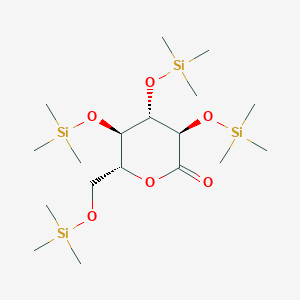

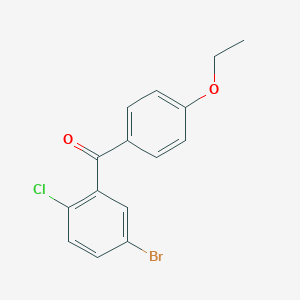
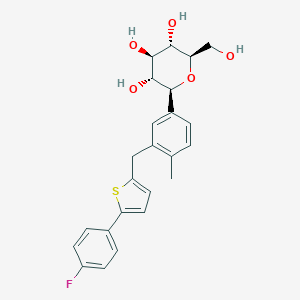

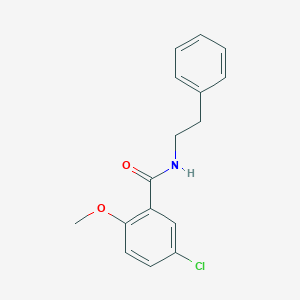
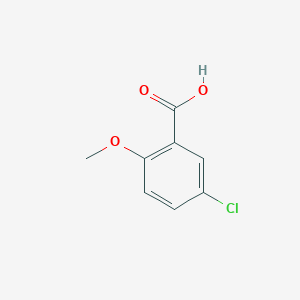
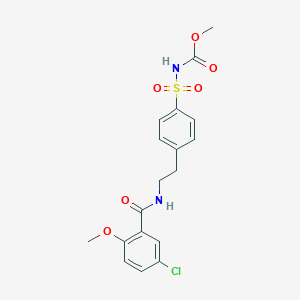
![4-[2-[(3-Ethyl-4-methyl-2-oxo-3-pyrrolin-1-yl)carboxamido]ethyl]benzenesulfonamide](/img/structure/B192893.png)
